This article may contain affiliate links. Please see our affiliate disclaimer in the footer menu for more information. Thank you for your support!
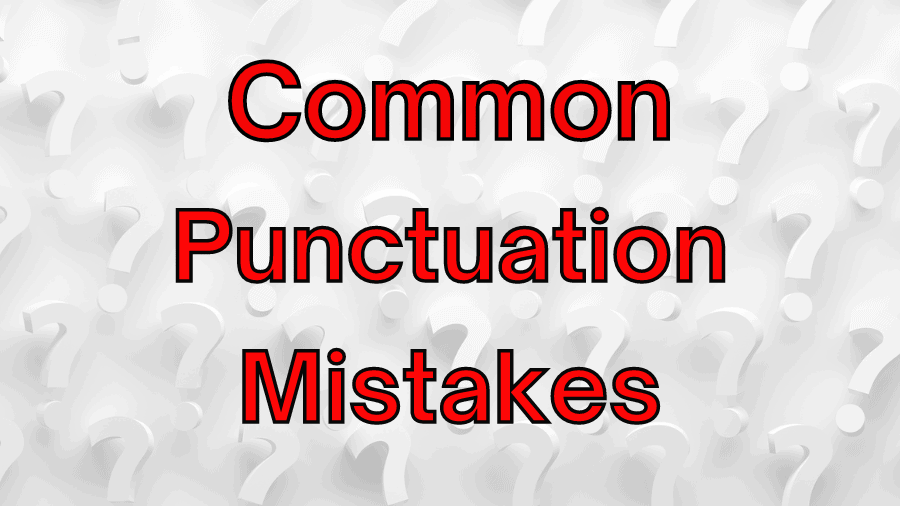
Punctuation mistakes are everywhere!
The problem is that these errors can make you appear less credible or professional. Polished writing is a sign of someone who cares about their work and pays attention to the details.
Common Punctuation Mistakes that Make You Look Careless
Let’s discover some of the most common punctuation mistakes that people make.
1) A Period Where a Question Mark Is Needed
I’m surprised by how often I witness this mistake, and I’m even more surprised by how many times I’ve made this misstep!
Incorrect: What kinds of drinks should we bring to the party.
Explanation: This is a question, so we need a question mark at the end of this sentence.
Correct: What kinds of drinks should we bring to the party?
2) A Question Mark Where a Period Is Required
Here’s another mix-up with end punctuation.
Example 1
Incorrect: David wondered if all his hard work was worth it?
Explanation: David is wondering about his work, not asking about it. We use question marks for direct questions but not for indirect questions.
Correct: Do you think all my hard work is worth it?
Example 2
Incorrect: My sister asked whether we planned to go swimming on Saturday?
Explanation: This isn’t a direct question. It’s a statement about a question that has been asked.
Correct: My sister asked whether we planned to go swimming on Saturday.
Correct: Are you and Sally planning to go swimming on Saturday?
3) Two Spaces after a Period
Nowadays, we use only one space after a period. I think it’s great we only have to hit the space bar once after every sentence. Who wants to do twice as much work? 😉
Incorrect: Brad wanted to take a hike. It was the perfect day for a long walk.
Explanation: When it comes to spaces, leave one. Then you’re done.
Correct: Brad wanted to take a hike. It was the perfect day for a long walk.
4) A Period after an Abbreviation That Ends with a Period
One period is sufficient to end a sentence.
Incorrect: Mia set her alarm clock for 6 a.m..
Explanation: If an abbreviation that ends with a period comes at the end of a sentence, you don’t need an extra period.
Correct: Mia set her alarm clock for 6 a.m.
5) Excessive Exclamation Points
If we overuse exclamation points, they lose their effectiveness.
Incorrect: We can use punctuation marks to emphasize a point or express strong feelings! We can also put them at the end of a sentence when we’re shouting! Thanks to exclamation points, we can express ourselves more effectively!!
Let’s let The Chicago Manual of Style (CMOS) weigh in on this. CMOS is a well-respected style guide that has guidelines for punctuation.
“An exclamation point (which should be used sparingly to be effective) marks an outcry or an emphatic or ironic comment.”
-CMOS
Explanation: You’ll only get away with multiple exclamation points in very informal communication, such as a text message to a friend.
Correct: We can use punctuation marks to emphasize a point or express strong feelings. We can also put them at the end of a sentence when we’re shouting. Thanks to exclamation points, we can express ourselves more effectively!
6) Inconsistent Use of the Oxford (Serial) Comma

The Oxford comma (aka serial comma) is the comma we use after the next-to-last item in a series of three or more items.
Example: She went to the farmers’ market to buy carrots, cucumbers, and lettuce.
The Oxford comma in the sentence above comes after the word cucumbers.
Several well-known style guides call for using the Oxford comma. However, one popular guide that leaves out the serial comma (unless needed for clarity) is The Associated Press Stylebook.
If you use the Oxford comma, do so consistently. Consistency is essential for producing polished, professional-looking prose.
Incorrect: Edward’s hobbies include hiking, swimming, and reading. His sister Mariah enjoys biking, writing and singing.
Explanation: We used the Oxford comma in the first sentence, so we need one in the second sentence too.
Correct: His sister Mariah enjoys biking, writing, and singing.
7) Cringeworthy Comma Splices
A comma splice occurs when we join two independent clauses with a comma.
An independent clause can stand by itself because it’s a complete sentence.
A comma isn’t strong enough to separate two independent clauses.
Incorrect: She picked up the pretty seashell, she gave it to her friend.
Here are three ways to turn a comma splice into something nice:
1) Correct: She picked up the pretty seashell. She gave it to her friend.
Explanation: We can use a period to make two separate sentences.
2) Correct: She picked up the pretty seashell; she gave it to her friend.
Explanation: A semicolon is strong enough to separate two independent clauses.
3) Correct: She picked up the pretty seashell, and she gave it to her friend.
Explanation: A comma paired with a coordinating conjunction is also strong enough to separate two independent clauses.
There are only seven coordinating conjunctions in English:
- for
- and
- nor
- but
- or
- yet
- so
We can remember them with the acronym FANBOYS.
8) No Comma after an Introductory Dependent Clause
We use a comma after a dependent clause that comes before an independent clause.
A dependent clause can’t stand alone because it’s not a complete sentence.
Dependent clauses usually start with a subordinating conjunction.
Here are examples of subordinating conjunctions:
- after
- as
- because
- before
- except
- if
- once
- rather
- since
- though
- unless
- until
- when
- while
- why
- without
Incorrect: When he was young he loved to play with toy dinosaurs.
Explanation: “When he was young” is a dependent clause. It can’t stand alone as a sentence. However, “he loved to play with toy dinosaurs” is an independent clause. It can stand alone as a sentence.
Therefore, we need to put a comma after the dependent clause that comes before the independent clause.
Correct: When he was young, he loved to play with toy dinosaurs.
Note: A comma usually isn’t needed when a dependent clause comes after an independent clause.
Correct: He loved to play with toy dinosaurs when he was young.
9) No Comma with a FANBOY Joining Two Independent Clauses

Let’s review the FANBOYS: for, and, nor, but, or, yet, and so.
A FANBOY by itself isn’t strong enough to separate two independent clauses. To do this, we need a comma before a FANBOY.
Incorrect: Jeff decided to take a bike ride so Jen took the dog for a walk.
Explanation: We need a FANBOY and a comma to separate these two independent clauses.
Correct: Jeff decided to take a bike ride, so Jen took the dog for a walk.
10) Not Using Commas to Set Off a Parenthetical Expression
A parenthetical expression provides additional information that we can take out of a sentence without changing the sentence’s meaning.
Incorrect: The waterfall in all its glory was over one thousand feet tall.
Explanation: We can remove the parenthetical expression “in all its glory” without changing the sentence’s meaning. The phrase “in all its glory” is nonessential information; it isn’t essential to understand what the sentence is trying to tell us.
Correct: The waterfall, in all its glory, was over one thousand feet tall.
11) Not Using a Comma in between Coordinate Adjectives
Coordinate adjectives are two or more side-by-side adjectives that modify (describe) a noun and fulfill two conditions:
- The sentence keeps its intended meaning when we put the coordinating conjunction and between the adjectives.
- The sentence still makes sense if the coordinate adjectives switch places.
We use commas to separate coordinate adjectives.
Before we see an incorrect sentence, let’s see one that’s correct.
Example 1
Correct: The girl admired the beautiful, tall tree.
Explanation: The adjectives beautiful and tall are coordinate. Therefore, they should be separated by a comma.
We know they’re coordinate adjectives because they meet our criteria.
- The girl admired the beautiful and tall tree. (can be joined by and)
- The girl admired the tall, beautiful tree. (can switch the adjectives)
Incorrect: The girl admired the beautiful tall tree.
Again, we need a comma to separate beautiful and tall since they’re coordinate adjectives.
In the following example, let’s first look at an incorrect sentence.
Example 2
Incorrect: Evan bought new, hiking boots yesterday.
Explanation: Although new and hiking are consecutive (side-by-side) adjectives that modify the noun boots, they aren’t coordinate adjectives.
- Evan bought new and hiking boots yesterday. (can’t be joined by and)
- Evan bought hiking new boots yesterday. (can’t switch the adjectives)
Correct: Evan bought new hiking boots yesterday.
Explanation: We don’t put a comma between new and hiking because they aren’t coordinate adjectives.
12) Omitting Commas with Repeated Adjectives

We typically put a comma between repeated adjectives that come before a noun.
Incorrect: The old old cabin was nestled deep in the woods.
Welp, we’re one comma short of a solid sentence.
Correct: The old, old cabin was nestled deep in the woods.
13) A Semicolon without a Complete Sentence on Each Side
Semicolons are often used between two closely related independent clauses. Remember that an independent clause can stand on its own as a complete sentence.
Incorrect: The iguanas sat on a large rock; relaxing in the heat of the sun.
Explanation: “Relaxing in the heat of the sun” is not a complete sentence because it doesn’t contain a subject.
Correct: The iguanas sat on a large rock; they enjoyed relaxing in the heat of the sun.
We added a subject to what comes after the semicolon, making it a complete sentence.
Now we have two closely related independent clauses separated by a semicolon. Nice! 😊
14) No Semicolons to Help Clarify a Comma-Heavy Sentence
When units of a series contain punctuation within themselves, we need to separate the units with semicolons to make the sentence easier to read.
Incorrect: He has gone camping in Bend, Oregon, Boise, Idaho, and Bremerton, Washington.
Explanation: It looks like we have six different elements when we only mean to have three. Semicolons come to the rescue here to separate the units properly.
Correct: He has gone camping in Bend, Oregon; Boise, Idaho; and Bremerton, Washington.
Ah, clarity!
15) Not Using a Semicolon before a Conjunctive Adverb
A conjunctive adverb joins two independent clauses and shows the relationship between them.
Here are a few examples of conjunctive adverbs:
- however
- indeed
- thus
- therefore
- nevertheless
- besides
- accordingly
- consequently
We use a semicolon before a conjunctive adverb and a comma after it.
Incorrect: They thought they could hike the trail in three hours, however, it ended up taking them four.
Explanation: The conjunctive adverb however connects two independent clauses:
- They thought they could hike the trail in three hours. (a complete sentence)
- It ended up taking them four. (also a complete sentence)
Therefore, we need to use a semicolon (not a comma) before however.
Correct: They thought they could hike the trail in three hours; however, it took them four.
16) Using a Colon after an Incomplete Sentence
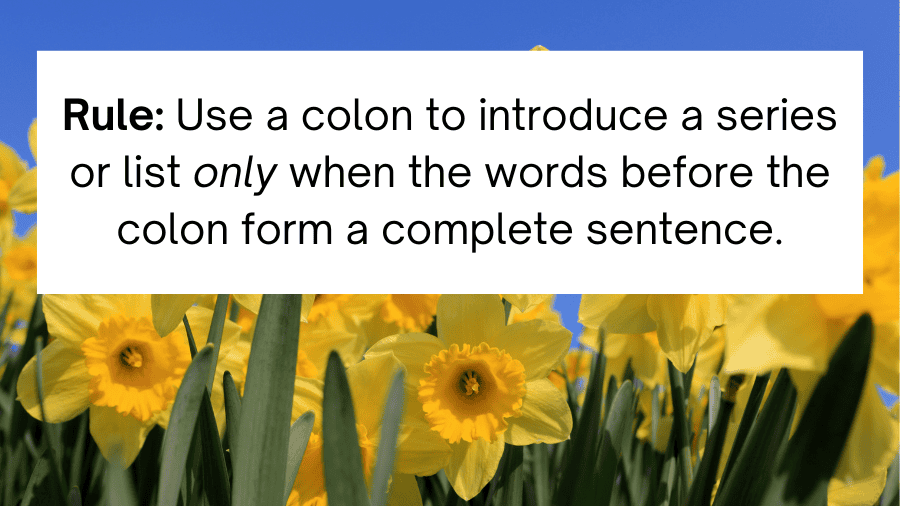
A colon is often used to introduce a list or a series. However, what comes before the colon must form a complete sentence.
In other words, what comes prior to the colon must be an independent clause.
When people misuse a colon, they frequently put it immediately after the verb in a string of words that doesn’t form a complete sentence.
Incorrect: My mom’s favorite flowers are: roses, daffodils, and pansies.
Explanation: The colon comes after an incomplete sentence, which is a no-no.
Correct: My mom has three favorite flowers: roses, daffodils, and pansies.
“My mom has three favorite flowers” is an independent clause. It can stand alone as a complete sentence.
17) Using a Semicolon When You Need a Colon
As we’ve learned, we can use a colon to introduce a series or a list if a complete sentence comes before the colon.
We can also use a colon after a complete sentence when what comes after the colon serves to illustrate or add to that sentence.
What comes after the colon can be one word, an independent clause, or anything in between.
Incorrect: I have a new hobby I adore; foraging for mushrooms.
Explanation: We use a semicolon to join two closely related independent clauses. However, “foraging for mushrooms” isn’t an independent clause. It can’t stand alone as a sentence.
Correct: I have a new hobby I adore: foraging for mushrooms.
18) Placement Problems with Parentheses and Periods
The period comes before the closing parenthesis when we enclose an entire sentence in parentheses.
Incorrect: Dan went swimming in Lake Michigan. (The water was ice cold that day). Then, he sat in the sunshine for the rest of the day.
Correct: (The water was ice cold that day.)
If the closing parenthesis comes at the end of the sentence but doesn’t enclose a whole sentence, the period goes after the closing parenthesis (like this). 😊
19) Overdoing It with Dashes
Dashes are versatile punctuation marks that add interest to your writing.
Incorrect: Certain writers depend on dashes—and only dashes—whenever they need to inject a pause—or a parenthetical element—into their prose. Although dashes are dandy—they do come in handy—using them too much annoys readers.
Author Rebecca Elliott says the following about dashes:
“If you use too many of them—as I’ve done here—your writing looks like it’s covered with snail tracks—not to mention chopped up and silly.”
– from Elliott’s book Painless Grammar
Correct: Certain writers depend on dashes—and only dashes—whenever they need to inject a pause or a parenthetical element into their prose. Although dashes are dandy (they do come in handy), using them too much annoys readers.
20) Hyphenating a Compound Adjective That Follows a Noun
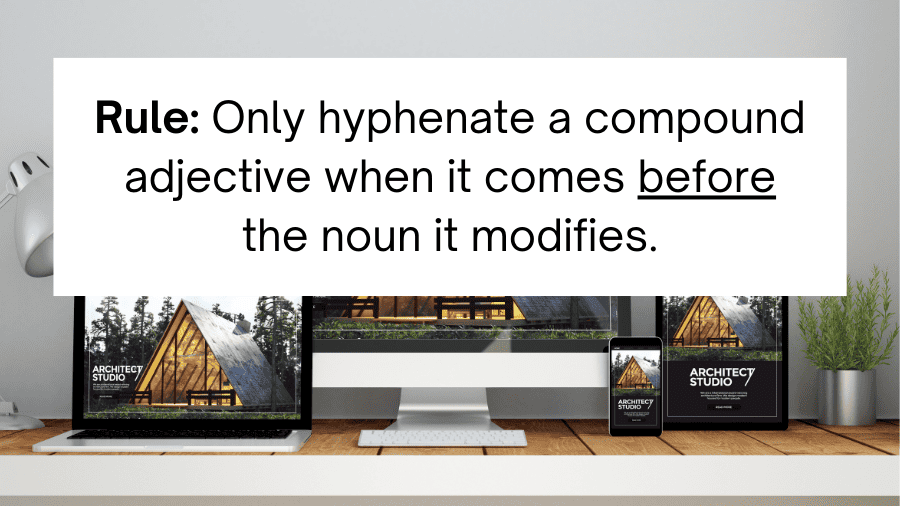
A compound adjective is an adjective that’s made up of two or more words. Remember, adjectives modify nouns and pronouns.
Generally, we only need to hyphenate a compound adjective when it comes before the noun it modifies.
Incorrect: The website contains information that is up-to-date.
Explanation: The compound adjective up to date modifies the noun information. Since the compound adjective comes after the noun, it shouldn’t be hyphenated.
Correct: The website contains information that is up to date.
Correct: The website contains up-to-date information.
21) Using an Apostrophe to Make a Word Plural
We use apostrophes to indicate possession and stand in for missing letters in contractions (e.g., can’t, they’ll).
If you use an apostrophe plus s to make a word plural, the grammar police will promptly arrest you. At least, I think that’s what happens. 😉
Incorrect: We saw several house’s for sale in her neighborhood.
Explanation: To make the noun house plural, just add an s. Since the house doesn’t own anything, we don’t need an apostrophe.
Correct: We saw several houses for sale in her neighborhood.
22) Using an Apostrophe with Possessive Pronouns
Possessive pronouns indicate ownership (e.g., yours, his, its, their).
Let’s see two sentences with possessive pronouns.
Example: That cookbook is ours.
Example: The bird flapped its wings.
We don’t use apostrophes with possessive pronouns.
However, one of the most common punctuation errors is using it’s when you need its.
It’s is a contraction meaning it is.
Its is a possessive pronoun.
Incorrect: The puppy licked it’s paw.
Explanation: We don’t want to say the puppy licked it is paw.
Correct: The puppy licked its paw.
The words it’s and its are homophones. Words that are homophones sound alike but differ in meaning and (usually) spelling. Homophones can be confusing!
23) Using Quotation Marks with Indirect Speech
Direct quotations are enclosed with quotation marks. A direct quotation is exactly (word for word) what someone said.
However, we don’t use quotation marks when we’re talking about what someone said but not using their exact words.
Incorrect: My sister told me she “needs to go to the grocery store on Tuesday night.”
Explanation: I’m talking about what my sister said, but I’m not using her exact words.
Correct: Catherine said, “I need to go to the grocery store on Tuesday night.”
Correct: My sister told me she needs to go to the grocery store on Tuesday night.
That concludes our conversation about common punctuation mistakes.
24) Not Using Closing Quotation Marks or Parentheses
In proofreading and copyediting documents for clients, I’ve found many instances of quotation marks and parentheses that are left open. This mistake can also happen with brackets.
I’ve noticed this usually happens when several sentences need to be placed in quotation marks or parentheses. I think it’s easier for us to remember the closing mark for one sentence than for many sentences.
Incorrect: John Lennon said, “You may say I’m a dreamer, but I’m not the only one. I hope someday you’ll join us. And the world will live as one.
Explanation: The poor quotation mark at the beginning of this quote is all alone. Let’s help it find its other half so we can properly enclose Lennon’s words!
Correct: John Lennon said, “You may say I’m a dreamer, but I’m not the only one. I hope someday you’ll join us. And the world will live as one.”
Phew! That’s better! 😊
Frequently Asked Questions
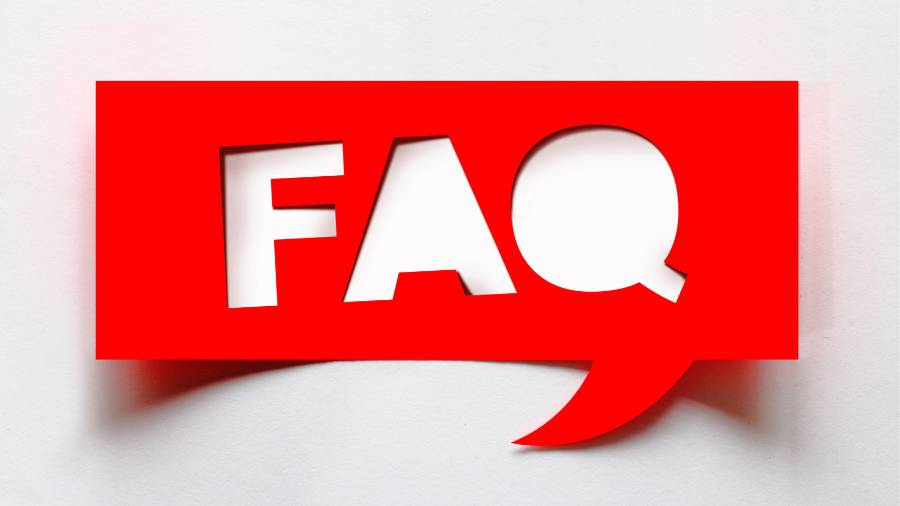
Why is punctuation important?
Punctuation is important because it shows us how sentences are supposed to be read. It makes writing easier to understand by demonstrating how parts of a sentence are related, indicating when to pause, conveying the right tone, and accurately expressing information.
Proper punctuation helps employees appear professional and attentive, assists job seekers with landing positions, and aids students with getting better grades.
Finally, if you’re still not convinced that punctuation is important, think about the difference between these two sentences that are part of a popular internet meme:
- I’m sorry, I love you.
- I’m sorry I love you.
The first sentence makes me think of hearts, hugs, and kisses. Aw! But the second one brings to mind tears, regret, and bad wishes. Yikes!
What a difference a comma can make!
If you’d like to delve deeper into why punctuation is essential, I penned a post called “6 Reasons Why Punctuation Is Important (with Examples).”
What is the most challenging punctuation mark to master?
The comma is the most challenging punctuation mark to master because it is associated with so many rules. CMOS dedicates more pages to commas than any other punctuation mark. Mastering these marks requires plenty of practice and repetition.
Hyphens are also a challenge. The hard part about hyphens is that you sometimes must be able to identify parts of speech for proper hyphenation.
Quiz: Punctuation Errors
Now that you’ve pondered a plethora of punctuation pitfalls, are you prepared to prove your punctuation proficiency by taking a quiz? I hope so!
Note: If you answer a question incorrectly, I’ll let you know which point (#1–#24) you need to review from this article. 😊
Important: After finishing the quiz, you’ll need to scroll up the page to click the “View score” button.
I hope this article has helped you understand common punctuation mistakes.
If you’d like to learn about specific ways to get better at punctuation, this article on Om Proofreading has you covered.
Best wishes to you!
“Isn’t it nice to think that tomorrow is a new day with no mistakes in it yet?”
– L.M. Montgomery
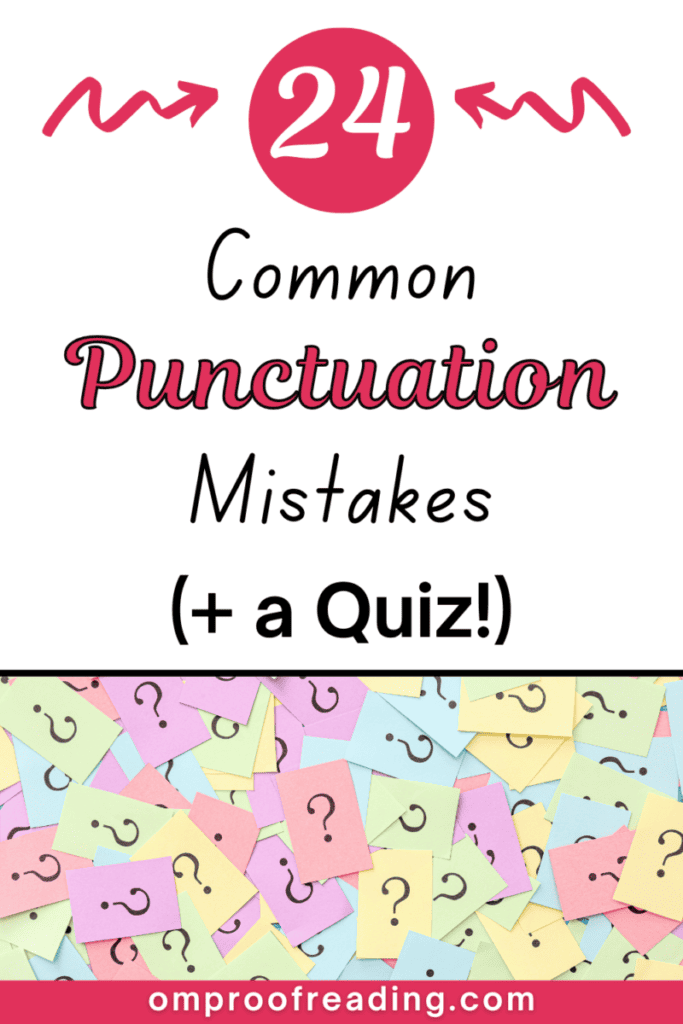
Recent Posts
Punctuation is important because it enables us to communicate our message clearly and effectively. Without punctuation, we wouldn’t understand how units of a sentence relate to one another or how...
Although you're probably somewhat familiar with adverbs, you may be unaware of sentence adverbs. As a trained proofreader who has studied the parts of speech, I can help you understand this unique...
